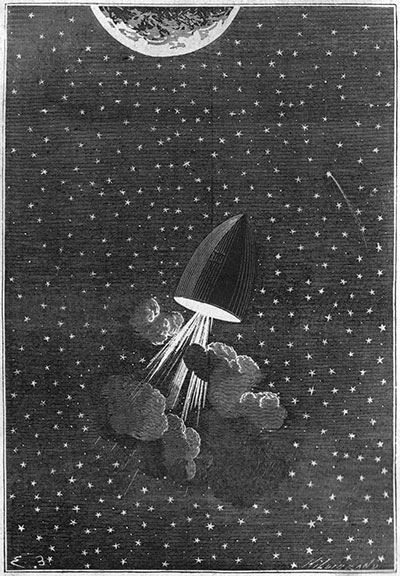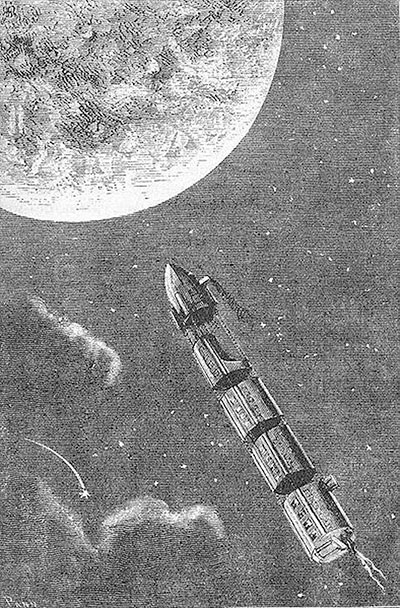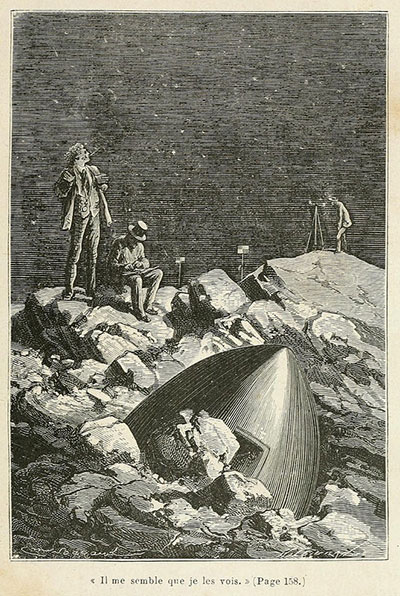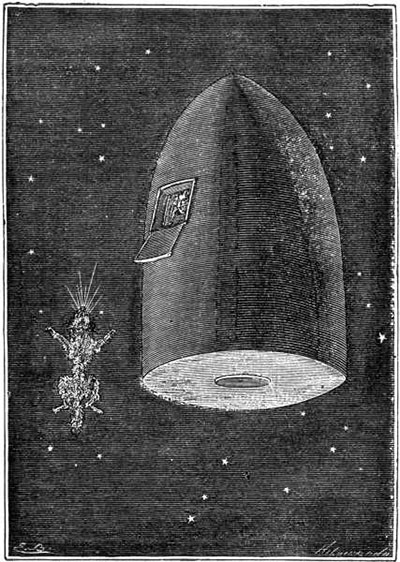|
|

|
|
Author
|
Topic: Jules Verne's moon voyages and book art
|
Explorer1
Member Posts: 88
From: Los Angeles, CA, USA
Registered: Apr 2019
|
 posted 12-07-2019 11:08 AM
posted 12-07-2019 11:08 AM
   
Has anyone ever read the two famous books by Jules Verne that foresaw a mission like Apollo 8 mission by 100 years? And more to the point, does anyone here have a detailed memory about the artwork in those books?Verne's two space books were "From Earth to the Moon" published in 1865, and its sequel, "Around the Moon" published in 1870. The books are most closely associated with the Apollo 11 mission because the Apollo 11 crew took the suggestion of naming their CSM "Columbia" in honor of the "Columbiad" cannon in Verne's story that launched a manned spacecraft shaped like an artillery shell toward the moon. The fictional space mission in Verne's story was actually a circumlunar journey that took a three-man crew around the moon and directly back to Earth without ever landing on the moon, similar to the Apollo 8 mission. But there is artwork associated with these books that conflict with the story. I wonder if anyone knows why this is. Below are four images associated with the two books and the first shows the artillery shaped spacecraft hurtling toward the moon. But on the cover of the book is a train-like version of the spacecraft. Does anyone know what the reason for the train version was?  
Secondly, the three occupants of the spacecraft had originally intended to land on the moon (with breaking rockets). But an asteroid threw the spacecraft off course and they wound up looping around the moon instead on a free trajectory return. Yet there is an illustration that shows all three men exploring the surface of the moon. Can anyone explain this?  The occupants of the spacecraft brought a dog with them and apparently the dog died in the course of the flight. So they opened a hatch on the spacecraft long enough to dispose of the dog and they closed the hatch up again. The illustration of the dog shows some activity from the dog's mouth. Was the dog still alive and barking or was this suppose to represent air escaping from the dog's body? And what was the cause of the dog's demise?  Did Verne's characters have a return option had they landed on the moon? Would the braking rockets that softened their landing been used to propel the spacecraft off the moon as well? |
hornetplusthree
New Member Posts: 4
From: Mulhouse, France
Registered: Aug 2012
|
 posted 12-22-2019 07:07 AM
posted 12-22-2019 07:07 AM
   
Much has been said and written about these two fantastic books published in 1865 for the first and 1869 (!) for "around the moon." You can read them, enjoy the 19th century writing style, but also find all the resemblances (and differences) also with the Apollo program, and before all keep in mind that these two books were a great source of inspiration for people like Tsiolkovsky, Oberth, later Von Braun, and many others. It certainly had played its part in all what happened with space after WWII, and you will notice in the book that the moon trip happens also after a a war (Civil War), because Verne imagines that then the artillery industry was useless and jobless, the artillerymen tried to find a peaceful goal for the USA! About your questions, the engravings in the books were probably made for attracting interest and buyers, so they sometimes refer to some particular sentences and seeing them, one want to go inside the text. Your first engraving depicts the "spacecraft" making a powder-rocket assisted trajectory correction, even if in the story they do not make one (if I good remember). As for the train-like version projectile, this is for illustrating a sentence saying that "in the future" such spacecraft will make the connection between Earth and Moon.
Regarding the travellers landed on the moon, the sentence under the engraving reads "I think I see them" in French, because in the story, there is no communication possible with Earth and they try to see a sign of the travellers with telescopes. So they imagine that they are landed, but without information. For the dog, I have no explication. You can easily find old and new editions of the books on the web and bookstores, in my opinion the engraving are 100% part of the books and it is missing something when you read only the text. Enjoy! |
Explorer1
Member Posts: 88
From: Los Angeles, CA, USA
Registered: Apr 2019
|
 posted 12-28-2019 08:14 PM
posted 12-28-2019 08:14 PM
   
Thank you so much for the edifying details on the engravings. Was highly informative. |
OLDIE
Member Posts: 268
From: Portsmouth, England
Registered: Sep 2004
|
 posted 01-01-2020 10:02 AM
posted 01-01-2020 10:02 AM
  
I've got an 1874 facsimile version of this book. I've found some more info after a brief skim through the contents (and more questions!).The illustration of the staged "trainlike" version of the rocket seems to relate to a discussion comparing the faster journey time of the proposed rocket with that of an express train. The only references to the rocket, in the text, refer to it as a projectile. There were originally two dogs (one female "Diana" and the other male "Satellite"). Satellite died of a fractured skull during launch, and was disposed of in space. His flattened corpse kept company with the rocket. No explanation is given for the apparent vapours from his mouth. The illustration of the men on the moon refers to the fantasising of a U.S. naval officer. He is on Earth aboard the survey ship Susquehanna and is picturing in his mind whether the rocket has landed on the moon, and what the crew might be doing. A final puzzle is how the crew were supposed to land on the moon and return from it. I could find no reference to this until nearly the end of the book, when one of the crew lights the train (of powder?) with a match, to set off the retro rockets. The projectile (and crew) return to earth and land in the sea. | |
Contact Us | The Source for Space History & Artifacts
Copyright 2020 collectSPACE.com All rights reserved.

Ultimate Bulletin Board 5.47a
|
|

|
 advertisement advertisement

|















